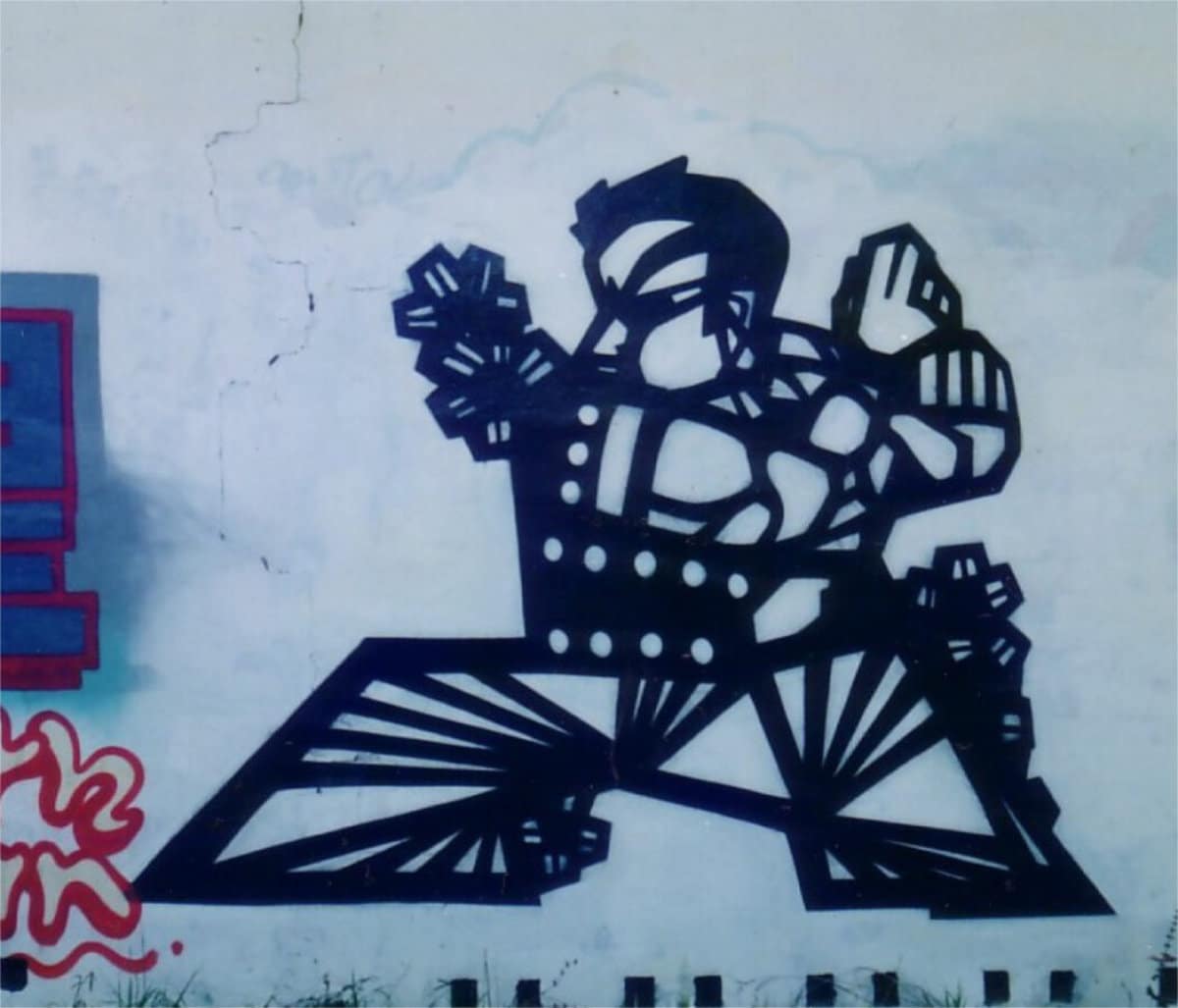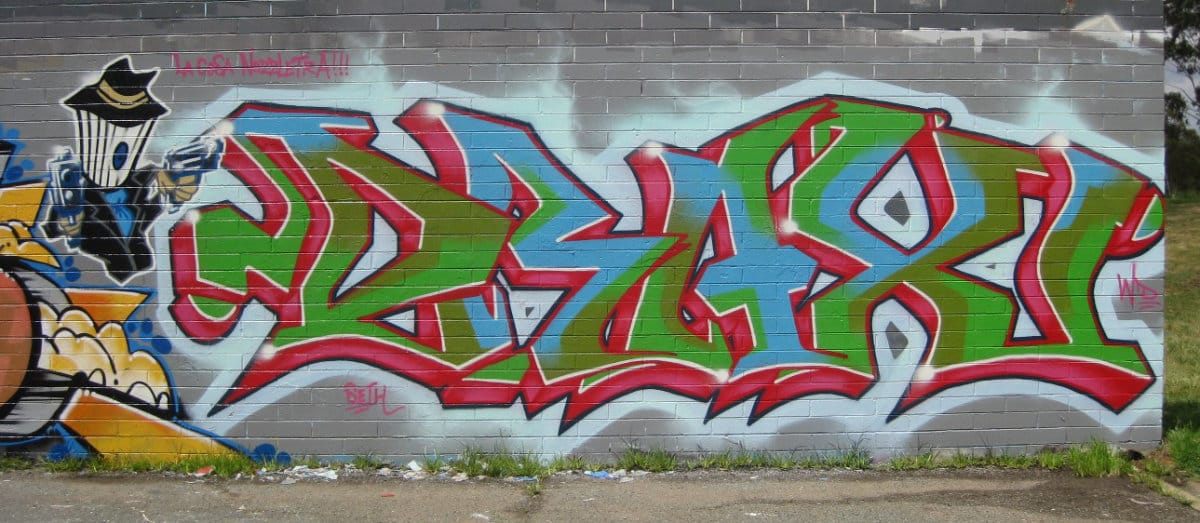SETH

“I was a b-boy (a breaker) first – starting with robot and boogie in 83, then breaking in 84 when it exploded in Australia. There was graffiti in that era but it was really all just knock offs of the stuff from the movies Beat Street and Breakdance. No one was bombing here yet. I did a couple of little things in my neighbourhood, but I was not what can be considered a writer until 86, when I was 14. I didn’t start piecing until 88. Like all things that become commercialised fads, breaking started to die, so I started writing instead. I was a skater from a young age, so was doing custom skateboard designs and skate and surf graphic influenced letters and had always been artistic, plus destructive. The transition was natural.
I skated since I was a young kid. My older brother was a part of a local team (FOD) and I skated at the Woden Skatepark in the early 80s before it became bankrupt and the owners smashed it up. The abandoned skatepark and the Woden Squash Court walls became important spots later. I’ve been involved in all aspects of hip hop since 83, particularly music.
In the first year or so apart from tags, I mainly went over pieces around Weston Creek and Tuggeranong with a single chrome ‘S’. I didn’t go over anything I thought was better, or was done by those who came before me though.
I’m from Kambah. The first b-boys and writers were all from Kambah, or at least from greater Tuggeranong and congregated in Kambah. The adventure playground was one of the main spots. I saw what was most likely the first real piece there in 85. I used to go there to practice breaking and also to skate and ride BMX in the half pipe. I knew of those boys (FBA) from breaking, but in those days you never really knew who wrote what, because there was understandable paranoia – on top of that I was just a kid to them, so they told me nothing. The scene was so small and the police were trying to crack down right from the beginning. They were the first-generation pioneers, including DEVIL and the bloke that went on to write RISK, TRICK, JINKS etc.
The younger brother of a member of FBA went to my school and we didn’t get on. Him and his brother Pex and Jinks (then Dex) pieced at and bombed my school in 86. I went over his tags, but didn’t touch the piece. I didn’t believe he was really hooked up with FBA and thought the tags were done after, as he wrote his own name and didn’t have their style. I only learned the truth 35 years later! RIP Daz. We definitely weren’t mates, but he put me on to Subway Art and that should be acknowledged.
I had a b-boy crew at that time, but I wasn’t a part of a graffiti crew until 88. I started bombing with a mate who wasn’t really a writer, just into vandalism, mainly in Tuggeranong and Weston Creek. I’m originally from Sydney but started going back up fairly regularly in 87, mainly to skate and also for football. I saw most of the better known walls and first met Sydney writers then. I joined one of the main three main post-ROF crews here from late 88 to mid-89 but dropped it pretty quickly. I only really got on with one of them (Quote) and we started putting up a Sydney crew (KOA) in late 89, which I wrote for 30 years. The crew was conceived in 88 but didn’t really become active until 89. The founding members were still writing DMA and 501 in 89 when they came down here – anyone who tells you otherwise is wrong.
(I have written as) Seth One consistently since 88. I wrote other names before that, Bust, Caos, Crazed etc. I’ve always put up my brothers that have passed away – Nipsta, Room One, Scotty B and Tron. World Domination and Creepshow crews.
A lot of my work has been in other cities, including overseas. Since 90, I’ve painted in the UK, throughout Europe, Asia, the US and the Pacific.
(I’ve had) a few things in Hype magazine and some international mags. I didn’t mind the double page spread in UK mag Hip Hop Connection with Kid Frost and Ralph M in front of my piece in the Ladbroke Grove ‘Pit’, painted in London in 90. Most important for me was Smoking Toast Crumbs, a legendary underground London zine that was only available to certain crews.

A lot of good writers have come out of Canberra, including some nationally recognised kings. We were an underdog for years and bigger cities looked down on us to some extent, mainly because we had no rail system. Canberra was and is mainly about walls and in the early days, buses (mainly insides). There’s a fair amount of street bombing too. A handful of writers from here have put in work in other cities and there are ex-Canberra refugees in positions of influence in the scenes of other major cities too, particularly Melbourne and Sydney, so our reputation is fairly solid.
(Canberra style) was very much influenced by the London style (at least the fills were) and Sydney stuff, such as TDF and RCF. The Killrust Black outlines were definitely Sydney influence. The style I’m talking about emerged later, mid 90s. The mid-late 90s Canberra stuff was kind of a fusion between my stuff, Shute, Bent and Rudes (particularly the pastel and earthy Tuxan and Krylon colour schemes and bright Touch Up outlines). Rvets (Wiske) on the Northside retained a strong Sydney style that developed independently. I was one of the first to break away from the black outline and hold-back method and start using full pressure and bright colour outlines. Canberra stuff was always very colourful, but in the early days, a lot of fades, whereas later, much more solid fills. Shute and Bent had mad colour schemes and unique fills. Canberra letters were always pretty unique. Shute’s letters in particular broke the New York mould.
The pieces were generally a lot smaller in the 90s, especially because of the smaller cans. So if you wanted to do anything bigger, but wanted to use the same cans and colours, sometimes you would do a double thickness outline to replicate a fat cap outline (if fat caps weren’t available or didn’t fit). If you used Tuxan nozzles on Touch Ups (which I generally did) this required a certain method to retain the cleanliness. Some of the younger generation writers watched me on a couple of the bigger walls and then they applied that method as a standard. Speaking with them years later, it became apparent that they didn’t realise that I only used that method on a few pieces, the rest being full pressure, single thickness outlines. It became the basis of their style and they took the cleanliness to extreme levels.
Well, (the internet) probably contributed to the death of what could be possibly called a Canberra style (though that style already had wide parameters). That had already started in the early 2000s though when the Sydney/Scram-influenced style became the most dominant here.


